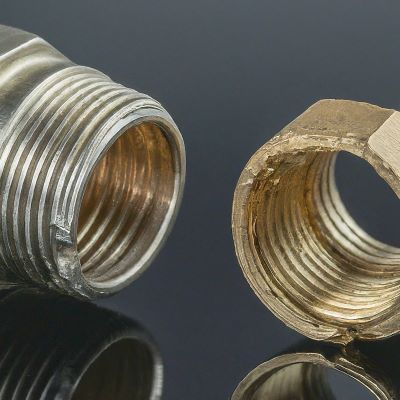In the high-pressure world of hydraulics, where even the smallest leak can lead to catastrophic failure, choosing the right connection components is crucial. Hydraulic adapters play a vital role in bridging the gap between different hoses, pipes, and valves. But when it comes to these connection warriors, a silent battle rages on: female vs. male adapters, which one reigns supreme in the hydraulic connection game?
Head-to-Head: Female vs. Male Hydraulic Adapters
Let’s dissect the strengths and weaknesses of female and male adapters across several key rounds:
Round 1: Sealing Performance
➡️ Female Adapters: These champions often boast a two-pronged attack on leaks. They typically utilize a combination of threads and crimping mechanisms for a secure hold on the hose or pipe. The crimped connection creates a tight seal around the fitting, while the threads provide additional reinforcement.
➡️ Male Adapters: These contenders rely primarily on threaded connections to form a seal. While effective for lower pressure applications, threaded connections can be more prone to leaks under high pressure if not installed correctly.
Round 2: Flow Efficiency
➡️ Female Adapters: The internal design of some female adapters can introduce slight restrictions due to the crimping mechanism. However, these restrictions are usually minimal and have a negligible impact on flow in most applications.
➡️ Male Adapters: Generally, male adapters offer a straighter flow path due to their simpler design. This can be advantageous in situations where minimizing pressure drops is critical.
Round 3: Versatility and Compatibility
➡️ Female Adapters: These versatile adapters shine in their ability to accept various male fittings with different sizes and thread types. This adaptability makes them ideal for connecting different components within a hydraulic system.
➡️ Male Adapters: These specialized adapters typically require a specific female counterpart with a matching thread pattern. This can limit their compatibility in applications requiring diverse connections.
Round 4: Ease of Use and Installation
➡️ Female Adapters: Installing female adapters often involves a two-step process: crimping the hose or pipe onto the fitting and then threading it into the counterpart. This can require specialized crimping tools and proper technique to ensure a secure seal.
➡️ Male Adapters: Generally, male adapters are easier to install, requiring only thread sealant and a wrench to tighten the connection. However, achieving a leak-proof seal relies heavily on proper thread engagement and avoiding over-tightening.
Round 5: Durability and Maintenance
➡️ Female Adapters: The recessed design of female adapters offers some protection for the crimped connection from external damage. However, the crimping itself can be a wear point over time, potentially requiring replacement of the hose or fitting.
➡️ Male Adapters: The exposed threads of male adapters make them more susceptible to physical damage and corrosion. This can lead to leaks and potential safety hazards.
Declaring the Champion (There Isn’t One!)
Hold on a minute! This isn’t a battle with a single victor. The ideal hydraulic adapter type depends entirely on your specific project needs.
➡️ Female adapters excel when prioritizing leak-proof security and versatility in connecting various components.
➡️ Male adapters might be preferable for situations requiring a simpler installation or minimizing pressure drops.
Choosing Your Hydraulic Adapter Champion
Now that you’ve seen the strengths and weaknesses of each contender, here’s a guide to picking the perfect hydraulic adapter for your project:
Consider system pressure and flow requirements: Choose an adapter with a pressure rating exceeding your system’s operating pressure. For critical flow applications, prioritize adapters with minimal internal restrictions.
Ensure compatibility with existing components: Match the adapter size, thread type, and material to your hoses, pipes, and valves.
Think about ease of installation and maintenance: If frequent disassembly is required, consider the complexity of the installation process for each adapter type.
Don’t forget about space constraints: Bulkier female adapters might not be suitable for tight spaces where a more compact male adapter could be ideal.
Beyond Gender: Building a Winning Connection
Remember, the battle isn’t about female versus male; it’s about choosing the right tool for the job. Here are some additional tips for a winning hydraulic connection:
➡️ Invest in high-quality adapters from reputable manufacturers.
➡️ Always follow the manufacturer’s recommended installation procedures and torque specifications.
➡️ Use thread sealant on male connections for an extra layer of leak prevention.
➡️ Regularly inspect your hydraulic system for signs of wear, damage, or leaks, and replace any compromised adapters promptly.
➡️ If tackling a complex project, don’t hesitate to consult with a qualified hydraulic specialist to ensure you select the most suitable adapters for your specific application.
Conclusion
In the realm of hydraulics, a successful connection isn’t about a battle of the sexes (or threads). It’s about understanding the strengths and weaknesses of each adapter type and selecting the one that best suits your project’s specific needs.
By considering factors like pressure, flow, compatibility, and installation ease, you can choose the winning adapter for a secure, leak-free hydraulic system. Remember, a well-connected system is a happy, high-performing system!
Post time: Mar-08-2024


